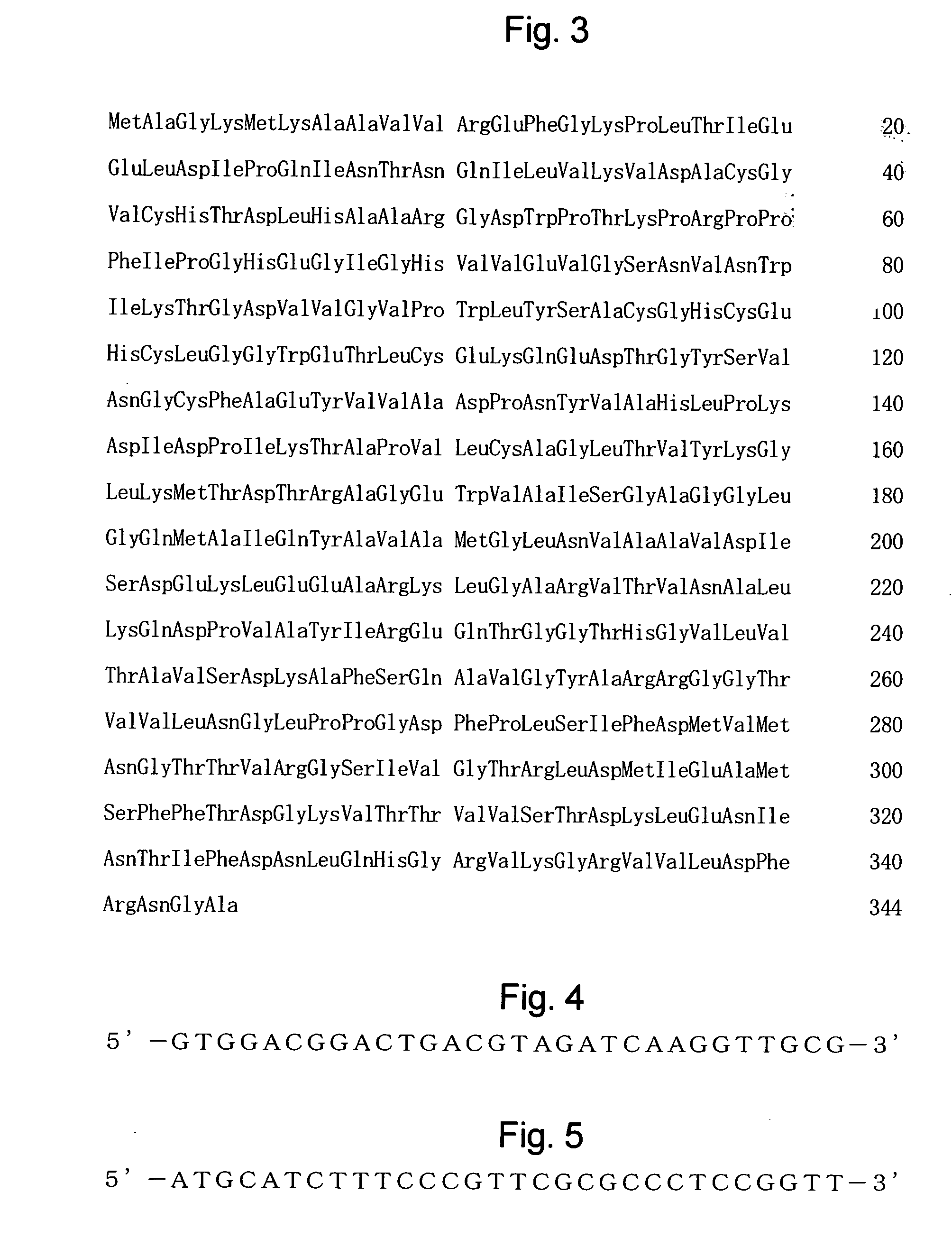Alcohol dehydrogenase gene of acetic acid bacterium
a technology of acetic acid bacteria and alcohol dehydrogenase, which is applied in the field of gene, can solve the problems of unreported successful cases, and achieve the effects of improving the growth-promoting function at practical level, high growth-promoting function, and improving the growth-promoting function
- Summary
- Abstract
- Description
- Claims
- Application Information
AI Technical Summary
Benefits of technology
Problems solved by technology
Method used
Image
Examples
example 1
Cloning of a Gene Having Growth-Promoting Function from Gluconacetobacter entanii and Determination of the Nucleotide Sequence and the Amino Acid Sequence thereof
(1) Construction of Chromosomal DNA Library
[0088] The Acetobacter altoacetigenes MH-24 strain (FERM BP-49 1), which is a strain of Gluconacetobacter entanii, was cultivated in shaking culture in YPG medium (3% glucose, 0.5% yeast extract, and 0.2% polypeptone) supplemented with 6% acetic acid and 4% ethanol at 30° C. After the cultivation, the culture medium was centrifuged (7,500×g for 10 minutes), thereby obtaining bacterial cells. From the thus obtained bacterial cells, chromosomal DNAs were prepared by a chromosomal DNA preparation method (e.g., see Patent document 3).
[0089] The above-obtained chromosomal DNAs were partially digested with a restriction enzyme Pst I (produced by TAKARA BIO INC.). Escherichia coi-acetic acid bacterium shuttle vector pMV24 was completely digested with the restriction enzyme Pst I. Appr...
example 2
Effect of Shortening the Growth Induction Period in a Transformant with a Gene Having Growth-Promoting Function Derived from Gluconacetobacter entanii
(1) Transformation into Acetobacter aceti
[0094] The above-cloned gene having the growth-promoting function derived from the Acetobacter altoacetigenes MH-24 strain (FERM BP-491) was amplified by the PCR method using KOD-Plus- (produced by TOYOBO CO., LTD.). The thus amplified DNA fragment was inserted into the restriction enzyme Sma I cleavage site of the acetic acid bacterium-Escherichia coli shuttle vector pMV24 (e.g., see Non-patent document 2), so as to prepare a plasmid pADH1. The amplified fragment inserted in pADH1 is schematically shown in FIG. 1. FIG. 1 shows the restriction enzyme map of the Gluconacetobacter entanii-derived gene fragment (pP1) cloned using Pst I, the position of the gene having the growth-promoting function, and the fragment inserted into pADH1.
[0095] The PCR method was carried out as described in detail...
example 3
Acetic Acid Fermentation Test for the Transformant with the Adh Gene Derived from Gluconacetobacter entanii
[0104] The ampicillin-resistant transformant having the plasmid pADH1 obtained in Example 2 and the original Acetobacter aceti No. 1023 strain having only the shuttle vector pMV24 were compared in terms of acetic acid fermentation ability.
[0105] Specifically, aeration and agitation culture (30° C., 400 rpm, and 0.20 vvm) was carried out using a 51 mini-jar fermentor (produced by Mitsuwa Scientific Corp.; KMJ-5A) containing 2.51 of YPG medium containing 1% acetic acid, 4% ethanol, and 100 μg / ml ampicillin. The strains were caused to ferment so as to result in an acetic acid concentration of 3%. Subsequently, each culture medium was removed while leaving 700 ml of the culture medium in the mini-jar fermentor. To the remaining 700 ml of the culture medium, 1.81 of YPG medium containing acetic acid, ethanol, and 100 μg / ml ampicillin was added. The medium was adjusted to result in...
PUM
| Property | Measurement | Unit |
|---|---|---|
| temperature | aaaaa | aaaaa |
| temperature | aaaaa | aaaaa |
| temperature | aaaaa | aaaaa |
Abstract
Description
Claims
Application Information
 Login to View More
Login to View More - R&D
- Intellectual Property
- Life Sciences
- Materials
- Tech Scout
- Unparalleled Data Quality
- Higher Quality Content
- 60% Fewer Hallucinations
Browse by: Latest US Patents, China's latest patents, Technical Efficacy Thesaurus, Application Domain, Technology Topic, Popular Technical Reports.
© 2025 PatSnap. All rights reserved.Legal|Privacy policy|Modern Slavery Act Transparency Statement|Sitemap|About US| Contact US: help@patsnap.com


